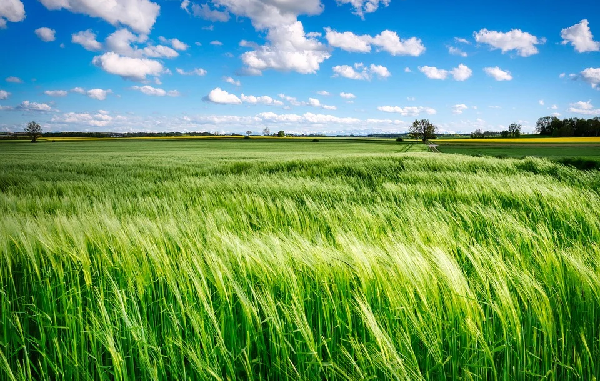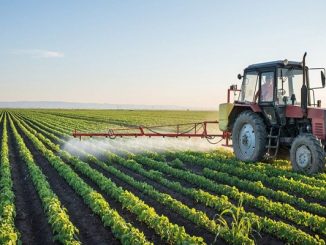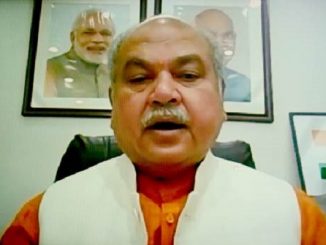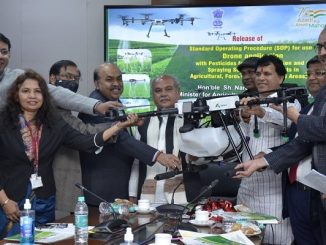
Feb 04: The government has adopted/implemented several developmental programmes, schemes, reforms and policies for reducing input costs in agriculture, higher production and achieving higher incomes for the farmers. These include:
- Unprecedented enhancement in budget allocation
In the year 2013-14 the budget allocation of the Ministry of Agriculture (including DARE) and the Ministry of Fisheries, Animal Husbandry & Dairying was only 30223.88 crore. This has increased by more than 4.59 times to Rs. 138920.93 crores in 2022-23.
- Income support to farmers through PM KISAN
Launch of PM-KISAN in 2019 -an income support scheme providing Rs. 6000 per year in 3 equal instalments. More than Rs. 2.24 lakh crore has been released so far to more than 11 crore farmers as of now.
- Pradhan Mantri Fasal Bima Yojana (PMFBY)
Six-year – PMFBY was launched in 2016 addressing problems of high premium rates for farmers and reduction in sum insured due to capping. In the past 6 Years of implementation – 38 crore farmer applications have been enrolled and over 12.37 crore (Provisional) farmer applicants have received claims. During this period nearly Rs. 25,252 crores were paid by farmers as their share of premium against which claims of over Rs. 1,30,015 crore (Provisional) have been paid to them. Thus for every 100 rupees of premium paid by farmers, they have received about Rs. 514 as claims.
- Institutional credit for the agriculture sector
- Increased from Rs. 7.3 lakh crore in 2013-14 with a target to reach Rs. 18.5 lakh crore in 2022-23.
- The benefit of concessional institutional credit through KCC at 4% interest per annum has also now been extended to Animal Husbandry and Fisheries farmers for meeting their short-term working capital needs.
- A special drive has been undertaken since February 2020 to provide concessional institutional credit with a focus on covering all PM-KISAN beneficiaries through Kisan Credit Cards (KCC). As of 23.12.2022, 387.87 lakhs new KCC applications have been sanctioned with a sanctioned credit limit of Rs. 4,49,443 crore as part of the drive.
- Fixing of Minimum Support Price (MSP) at one-and-a-half times the cost of production –
- The government has increased the MSP for all mandated Kharif, Rabi and other commercial crops with a return of at least 50 per cent overall India weighted average cost of production from 2018-19.
- MSP for Paddy (common) has increased to Rs. 2040 per quintal in 2022-23 from Rs. 1310 per quintal in 2013-14.
- MSP for Wheat increased from Rs. 1400 per quintal in 2013-14 to Rs. 2125 per quintal in 2022-23.
- Promotion of organic farming in the country
- Paramparagat Krishi Vikas Yojana (PKVY) was initiated in 2015-16 to promote organic farming in the country. 32384 clusters have been formed and an area of 6.53 lakh hectares has been covered benefitting 16.19 lakh farmers. In addition, Under Namami Gange Programme, a 123620-hectare area is covered and under natural farming 4.09 lakhs hectare area is covered. Farmers in Uttar Pradesh, Uttarakhand, Bihar and Jharkhand have taken-up organic farming on either side of the river Ganga to control river water pollution as well as to fetch additional income for farmers.
- The government also proposes to promote sustainable natural farming systems through the scheme Bhartiya Prakratik Krishi Padhati (BPKP). The proposed scheme aims at cutting down the cost of cultivation, enhancing farmers’ income and ensuring resource conservation and, safe and healthy soils, environment and food.
- Mission Organic Value Chain Development in North East Region (MOVCDNER) has been launched. 379 Farmer Producer Companies have been formed comprising 189039 farmers and covering 172966-hectare areas.
- Per Drop More Crop
Per Drop More Crop (PDMC) scheme was launched in the year 2015-16 which aims to increase water use efficiency, reduce the cost of inputs and increase productivity at the farm level through Micro Irrigation technologies i.e. drip and sprinkler irrigation systems. So far, an area of 69.55 lakh hectares has been covered under Micro irrigation through the PDMC scheme from the year 2015-16.
- Micro Irrigation Fund
A Micro Irrigation Fund of an initial corpus of Rs 5000 crore has been created with NABARD. In the Budget Announcement for 2021-22, the corpus of the fund is to be increased to Rs.10000 crores. Projects worth Rs 4710.96 crore covering 17.09 lakh hectares have been approved.
- Promotion of Farmer Producer Organisations (FPOs)
- A new Central Sector Scheme for Formation & Promotion of new 10,000 FPOs launched by the Prime Minister on 29th February 2020 with a budget outlay of Rs 6865 Crore till 2027-28.
- As of 30.11.2022, 4028 no. of FPOs have been registered under the new FPO scheme.
- An Equity Grant of Rs. 53.4 Crore has been released to 1415 FPOs as of 30.11.2022.
- As of 12.12.2022, Credit Guarantee Cover worth Rs. 78 Cr. Issued to 447 FPOs.
- A National Beekeeping and Honey Mission (NBHM) has been launched in 2020 as part of the AtmaNirbhar Bharat Abhiyan to increase the productivity of crops through pollination and increase honey production as an additional source of income. Rs. 500 crores for the period 2020-2021 to 2022-2023 has been allocated for the beekeeping sector. 114 projects for the assistance of about Rs. 139.23 crores, approved/ sanctioned for funding under NBHM during 2020-21 & 2021-22 till date.
- Agricultural Mechanization
- mechanization is extremely vital to modernize agriculture and reducing the drudgery of farming operations. During the period from 2014-15 to March 2022, an amount of Rs.5490.82 crore has been allocated for agricultural mechanization. 13,88,314 numbers of machines and equipment have been provided to farmers on a subsidy basis. 18,824 custom hiring centres, 403 high-tech hubs and 16,791 farm machinery banks have been established to make available agricultural machines and types of equipment to the farmers on a rental basis. During the current year i.e. 2022-23, so far an amount of Rs. 504.43 crores have been released for distribution of around 65302 machines on subsidy, the establishment of 2804 CHCs, 12 Hi-tech hubs and 1260 Village Level Farm Machinery Banks.
- Providing Soil Health Cards to farmers
Soil Health Card Scheme was introduced in the year 2014-15 to optimize the usage of nutrients. The following numbers of cards have been issued to farmers;
- Cycle I (2015 to 2017) – 10.74 crore
- Cycle II (2017 to 2019)- 12.19 crore
- Model Village Programme (2019-20)- 23.71 lakh
- In the year 2020-21- 11.52 lakh
- Setting up of National Agriculture Market ( e-NAM) extension Platform
- 1260 mandis of 22 States and 03 UTs have been integrated into the e-NAM platform.
- As of 29.11.2022, more than 1.74 Crore Farmers & 2.37 Lakh traders have been registered on the e-NAM portal.
- Total volume of 6.8 Crore MT & 20.05 Crore numbers (bamboo, betel leaves, coconut, lemon & sweet corn) collectively worth approximately Rs. 2.33 lakh crore of trade has been recorded on the e-NAM platform as of 29.11.2022.
- As of 01.12.2022, 203 Agriculture and allied products Tradable Parameter have been formulated for Assaying on the e-NAM platform
- Launch of the National Mission for Edible Oils – Oil Palm – NMEO has been approved with a total outlay of Rs 11,040 crore. This will bring an additional area of 6.5 lakh hectares under the Oil Palm plantations with 3.28 lakh hectares in the northeastern states and 3.22 lakh hectares in the rest of India in the next 5 years. The major focus of the Mission is to provide Viability Prices of fresh fruit bunches (FFBs) to the farmers linked with assured procurement by industry with a simpler price-fixing formula.
- Agri Infrastructure Fund (AIF)
Since the inception of AIF in the year 2020, the scheme has sanctioned an amount of Rs.14170 crore worth of agriculture infrastructure in the country for 19191 projects. With the support of the scheme, various agriculture infrastructures were created and some of the infrastructures are at the final stage of completion. These infrastructures include 8215 warehouses, 3076 primary processing units, 2123 custom hiring centres, 992 sorting & grading units, 728 cold store projects, 163 assaying units and around 3632 other kinds of post-harvest management projects and community farming assets.
- Improvement in farm produce logistics, Introduction of Kisan Rail.
Kisan Rail has been launched by the Ministry of Railways to exclusively cater to the movement of perishable agrihorti commodities. First Kisan Rail was started in July 2020. Till 31st December 2022, 2359 services on 167 routes have been operated.
- MIDH – Cluster Development Programme:
The Cluster Development Programme (CDP) is designed to leverage the geographical specialisation of horticulture clusters and promote integrated and market-led development of pre-production, production, post-harvest, logistics, branding, and marketing activities. DA&FW has identified 55 horticulture clusters, of which 12 have been selected for the pilot phase of the CDP.
- Creation of a Start-up Ecosystem in the agriculture and allied sector
So far, 1102 Startups during FY 2019-20 to 2022-23 have been finally selected by different knowledge partners and agribusiness incubators of DA&FW. A total of Rs. 66.83 crore grants-in-aid has been released for funding to these Startups to the respective Knowledge Partners (KPs) & RKVY RAFTAAR Agri-Business Incubator (R-ABIs) as grants-in-aid support by DA&FW.
19. Achievement in the Export of Agri and Allied Agri- Commodities
The country has witnessed emphatic growth in the export of agri and allied commodities. As compared to the previous year 2020-21, the Agri and allied export has increased from 41.86 billion USD in 2020-21 to 50.24 billion USD in 2021-22 i.e. an increase of 19.99%.
The efforts of the Government at the positive implementation of these schemes have yielded remarkable results towards augmenting the income of the farmers. As part of the ‘Azadi ka Amrit Mahotsav’, the Indian Council of Agricultural Research (ICAR) has released a book which contains a compilation of success stories of 75,000 farmers out of innumerable successful farmers who have increased their income more than two times.
Disclaimer: We donot claim that the images used as part of the news published are always owned by us. From time to time, we use images sourced as part of news or any related images or representations. Kindly take a look at our image usage policy on how we select the image that are used as part of the news.


